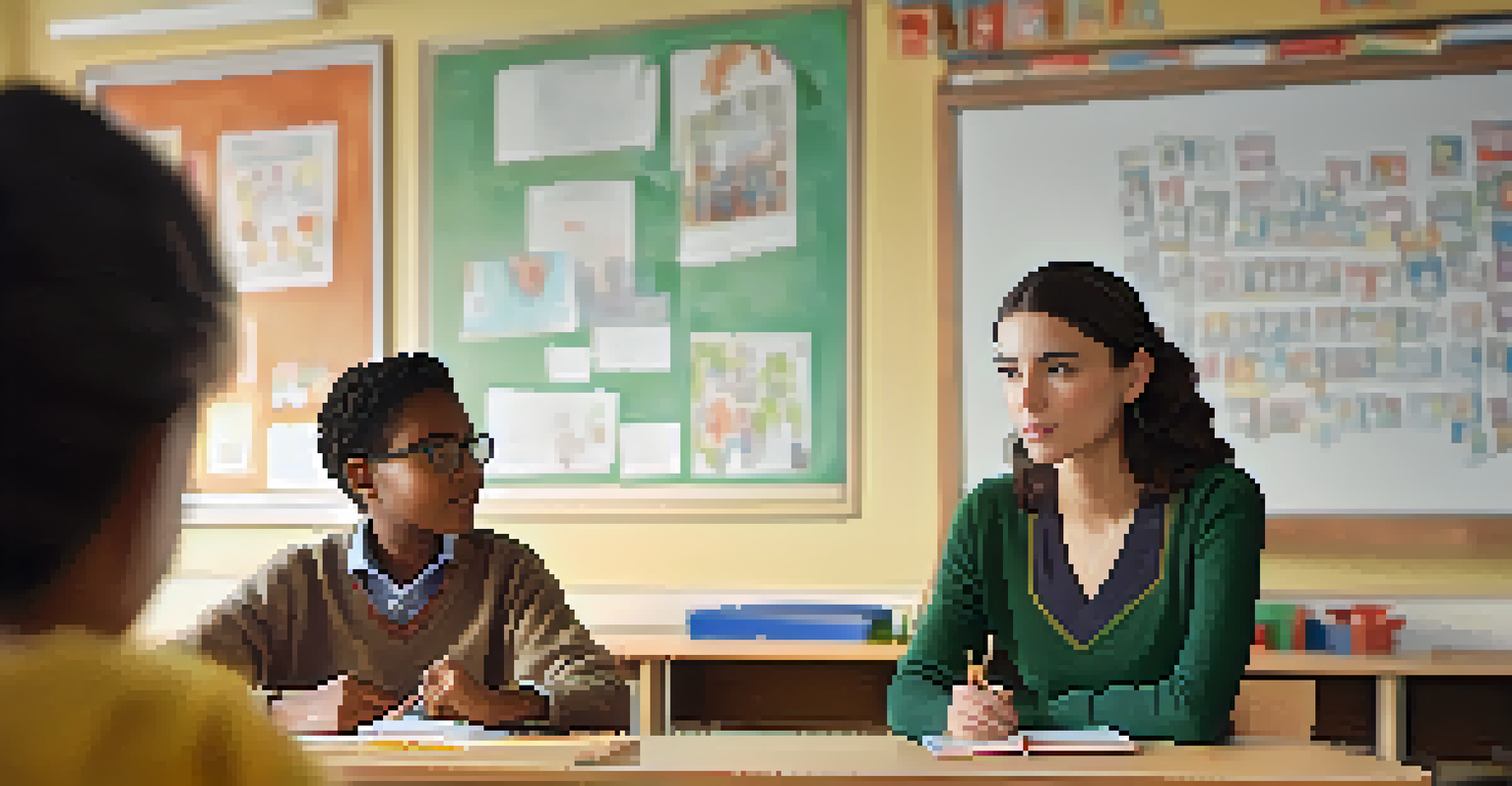Mindfulness for Building Trust in Student-Teacher Relationships

Understanding Mindfulness and Its Importance
Mindfulness is the practice of being fully present and engaged in the moment. It encourages awareness of thoughts and feelings without judgment, which can greatly enhance communication. In the context of education, mindfulness helps both teachers and students create a deeper connection, fostering an environment of trust.
Mindfulness is a way of befriending ourselves and our experience.
By practicing mindfulness, teachers can better understand their students' needs and emotions. This understanding is crucial because it allows educators to respond more empathetically. When students feel understood, they are more likely to open up, which is the first step toward building trust.
Furthermore, mindfulness can help reduce stress and anxiety for both teachers and students. A calm environment is conducive to learning and promotes positive interactions, enabling trust to flourish naturally.
The Role of Active Listening in Building Trust
Active listening is a key component of mindfulness that directly impacts the student-teacher relationship. It involves fully concentrating on what the speaker is saying and responding thoughtfully. When students feel that their voices are heard, it cultivates a sense of trust and respect.

Teachers can model active listening by maintaining eye contact and providing feedback to show they are engaged. This simple act demonstrates that the teacher values the student's perspective, reinforcing a trusting relationship. Over time, students will feel safer sharing their thoughts, leading to deeper connections.
Mindfulness Builds Trust in Classrooms
Practicing mindfulness enhances awareness and empathy, fostering trust between teachers and students.
Moreover, active listening encourages open dialogue, which is vital for effective communication. As trust builds, students become more willing to express their challenges, making it easier for teachers to provide the necessary support.
Creating a Safe and Supportive Classroom Environment
A safe classroom environment is essential for fostering trust. Mindfulness practices can help create this supportive atmosphere by encouraging positive interactions. When teachers model mindfulness, they set the tone for a classroom that prioritizes respect and understanding.
Listening is a magnetic and strange thing, a creative force. The one who listens is in the process of creating.
Incorporating mindfulness exercises, such as breathing techniques or short meditation sessions, can help students feel grounded. This practice not only reduces anxiety but also promotes a sense of belonging among students. A classroom that feels safe encourages students to take emotional risks, which is key to building trust.
Additionally, a supportive environment allows for mistakes and learning opportunities without fear of judgment. When students know they can express themselves freely, trust naturally develops, leading to a more cohesive classroom community.
The Impact of Empathy on Student-Teacher Relationships
Empathy is an integral part of mindfulness and is essential for building trust in education. When teachers approach their students with empathy, they validate their feelings and experiences. This validation fosters a strong bond and encourages students to be open and honest.
Teachers can practice empathy by putting themselves in their students' shoes, considering their backgrounds and challenges. This understanding can inform how they interact with students, making their responses more compassionate and effective. As a result, students feel more supported, which enhances trust.
Active Listening Strengthens Relationships
Active listening cultivates respect and connection, allowing students to feel understood and valued.
Moreover, empathic interactions create a culture of care within the classroom. When students feel cared for, they are more likely to reciprocate that trust, leading to a positive feedback loop that strengthens the relationship.
Mindfulness Techniques for Teachers to Enhance Trust
Teachers can employ various mindfulness techniques to enhance trust with their students. Simple practices, like taking a few deep breaths before addressing the class, can help create a calm atmosphere. This calmness translates to students, making them feel more at ease.
Another effective technique is to incorporate mindfulness moments into the daily routine. For example, starting each class with a brief mindfulness exercise can help center students’ attention and foster a sense of community. This shared experience reinforces trust among students and between them and the teacher.
Additionally, teachers can encourage students to practice mindfulness individually. Providing resources or guidance on mindfulness techniques empowers students to manage their emotions, which contributes to a trusting relationship as they learn to rely on their own skills.
Encouraging Student Participation Through Mindfulness
Encouraging student participation is crucial for building trust, and mindfulness can play a significant role. When teachers practice mindfulness, they create a space where students feel comfortable sharing their thoughts and ideas. This open environment promotes active engagement and collaboration.
Using mindfulness techniques, such as circle discussions, allows every student to share their perspectives. This approach not only values each student's voice but also fosters a sense of belonging. As students contribute, they build trust not only with the teacher but also with their peers.
Empathy Drives Student Engagement
Empathy from teachers validates students' experiences, encouraging openness and deeper trust in the classroom.
Furthermore, when students see their contributions valued, they become more invested in their learning. This investment deepens their trust in the teacher and enhances the overall classroom dynamic, creating a more vibrant learning community.
Mindfulness as a Tool for Conflict Resolution
Conflict is a natural part of any relationship, including those between students and teachers. Mindfulness can serve as a powerful tool for resolving conflicts when they arise. By remaining calm and centered, teachers can address conflicts with a clear mind and empathetic approach.
When conflicts are handled mindfully, teachers can guide students through their emotions and help them articulate their feelings. This process not only resolves the immediate issue but also strengthens the trust between the teacher and the student. Students learn that their feelings are important and worth discussing.

Moreover, teaching students mindfulness techniques for conflict resolution equips them with essential life skills. They learn how to manage their emotions and approach disagreements constructively, fostering a trusting environment where all voices can be heard.